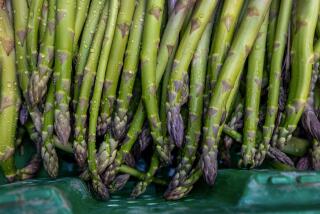GARDEN FRESH : Asparagus: A Burst of Green
- Share via
For an asparagus gardener, there are six weeks in a year, and that’s it. That’s 46 weeks without fresh-cut asparagus! Come to think of it, there are few crops as fleeting--only red currants come to mind.
To indulge properly, each person needs around 10 asparagus plants. With the most intensive spacing, that’s 12 1/2 square feet. That same space would give six times as many slicing tomatoes. Moreover, much of the year there’s asparagus at the market. Then why grow these cousins of lilies that first sprang up at distant seas?
Because asparagus that was connected to the earth only minutes before cooking is infinitely sweeter, tastier, more tender and juicier on your plate than asparagus picked who knows when and where. Because an asparagus patch is low-maintenance and long-lived--20 years is not uncommon. And because picking the first shoots of spring is one of a gardener’s cherished rites.
In the beginning of the season, all I want to do is taste asparagus on its own. I lay half a dozen raw stalks on the plate and we nibble them like rabbits. Then I cook stalks and dress them with olive oil and lemon juice or fine peanut oil and rice vinegar, or mayonnaise thinned with orange--or blood orange--juice. As the season advances, I get a yen to mix asparagus up a bit. Delicate asparagus is a soloist in the vegetable ensemble, but it gracefully lends its voice to an appealing duo or trio.
*
When you bring stalks into the kitchen, plunge them at once into a jug of cool water, just as you would flowers. To preserve their quality, keep the jug in the refrigerator and cook the stalks the same day.
To prepare stalks for cooking, swish them in cold water. Gently bend the lower two to three inches of each stalk until it snaps--where it snaps is the point between tough and tender. It depends on how long the stalks have been cut, but I find that trimming loses you between 1/4 and 1/3 of every pound. So to serve a pound of asparagus, start with a generous 1 1/4 pounds. Throw the ends into a pot, add water to cover and a sprinkling of salt to taste, cover and simmer until you have a flavorful stock for soup (freeze it for a taste of springtime in winter).
Cooking asparagus stalks is fast and easy. The best way is to simmer/steam them. Find a deep narrow pot you can cover tightly--a double boiler’s top inverted over its bottom works. If there aren’t enough stalks for them to hold each other upright, tie them in a bundle with cotton kitchen string. Bring a couple of inches of water to boil, stand the stalks in the water and cover. Start tasting after four to five minutes, depending upon the thickness of the stalks.
To be served cool as an hors d’oeuvre or salad, a stalk is ready when there’s a fine shaft of crunch at its heart. To be served hot as a side dish, the stalk should be tender all the way through--but barely.
*
Overcooking asparagus is a crime against nature. To reduce the chances of criminality, have a big bowl of ice water beside the stove. The instant you think the stalks are done, turn off the heat, lift the asparagus out with tongs and plunge them into the water--this stops the cooking. Finally, drain the stalks on folded dish towels, cover and pat dry. They can stay in the folds of the towels in a cool place for a few hours, if need be.
You can grow asparagus from seeds, but you lose a year of harvest compared with planting robust one-year crowns. Seeds are cheaper, if that’s a consideration. Directions come with the packet.
Plant crowns around the expected date of your last spring frost or when the weather has settled. Choose a place with good drainage and full sun where the four-foot roots will have no competition and the three- to five-foot fronds will be an asset in the border.
Keep the crowns moist while you prepare their bed. Get rid of weeds, then dig trenches at least eight inches deep and a foot wide. Dig in a couple of inches of compost--your own or from the nursery--and bone meal or rock phosphate according to package directions (use calcium phosphate on acid soil). Mix the soil from the trenches with equal parts compost or well-rotted manure.
*
Give each plant about 2 1/2 square feet to itself. Set the crowns on hillocks in the trenches about six inches below the surface, and spread the roots out carefully. Cover with two inches of soil and water well. In the coming weeks, as the crowns surface, repeat until all the reserved soil has been used. The asparagus beds will now be raised.
The first two years, keep the soil evenly moist spring through fall, and let rain do the watering while plants are dormant. Once established, the plants can get by on half the water of most vegetables, although more is welcome. Watch for slugs. Should you have problems (you probably won’t), consult a county agricultural adviser.
Don’t cut fronds for bouquets and wait till the third spring to harvest--the plants need their strength. The third year, pick for three weeks. Forever after, pick for six weeks. Harvest at six to nine inches while buds are tight--snap off the stalk just below the soil. Never harvest stalks 1/4 inch or thinner.
Mulch the patch with a couple of inches of compost or well-rotted manure three times a year: just after the harvest, when the fronds start browning in autumn, and in very early spring. If by January the fronds haven’t snapped of their own weight to make way for new shoots, cut them off at an inch or two, then chop and leave them for mulch.
*
Europeans are fond of ivory-colored asparagus, but it’s rarely fresh in our markets, and when it is, it costs a fortune. These luxury spears have been raised without sunlight, a process called blanching. Sometimes the stalks are a bit fibrous, but the ones we blanch in our garden are tender and even sweeter than those that embrace the sun. Usually soil or organic mulch is mounded eight inches high down a row and the shoots grow up through it. But I choose a few plants for blanching, set a tall flower pot over them and cover the pot’s drainage hole with a rock. It’s important to check often under the pot because the shoots shoot. Last week I found ivory asparagus twirling in figure-eights.
Blanched asparagus is prepared the same way as green, but do dramatize its color--use vibrantly colorful plates. When I serve it cold, I mix a little Dijon mustard into mayonnaise, then speckle with chopped fresh tarragon--or parsley, capers, or watercress. For blanched asparagus served hot, I stir tomato puree bit by bit into hot cream sauce until it’s the color of a Pacific sunset.
Asparagus is one of the most beautiful vegetables in the garden, with rich green lacy fronds from late spring through autumn. In late summer, it produces a stippling of red berries as decorative as holly, then chilly weather turns the lace cafe-au-lait.
So I’m wrong about just six weeks of feasting on asparagus. Asparagus is a long delicious feast to the eye!
Sources:
Fresh--Farmers markets and fine produce departments; March through most of May is the local season.
Crowns--Ask for UC 157 from Shepherd’s Garden Seeds, 6116 Highway 9, Felton, Calif. 95018.
Seeds--Ask for UC 157 F2 from Territorial Seed Co., 20 Palmer Ave, Cottage Grove, Ore. 97424.
*
This salad may be prepared a few hours in advance. It makes a handsome light luncheon or first course. Although bay shrimp offer the asparagus their soft pink color and another aspect of sweetness (I find Oregon shrimp larger and more flavorful than most), you can omit them and add 3/4 pound of trimmed asparagus for two or three more servings.
SICHUAN-STYLE ASPARAGUS AND SHRIMP SALAD 1 pound trimmed tender whole asparagus stalks (start with about 1/3 pound more) 1 (1-inch) piece ginger root, peeled and finely grated 2 1/2 tablespoons rice vinegar 2 tablespoons richly flavored peanut oil or olive oil 1 tablespoon plus 1 teaspoon low-sodium soy sauce 1 tablespoon fresh lemon juice 2 teaspoons sesame oil or 2 teaspoons sesame seeds toasted over medium heat in dry skillet Scant 1 teaspoon crumbled dried red chile with no seeds, or to taste 3/4 pound cooked bay shrimp, thawed if frozen and patted dry 1/2 cup thinly sliced green onions, tender stalks included Leaves of 1 large bunch watercress, rinsed and dried Freshly ground Sichuan peppercorns or black pepper 4 small unsprayed tulips, optional
Simmer or steam asparagus in pot until tender-crisp. Plunge into bowl of ice water to stop cooking, then pat dry on kitchen towels. Reserve.
To make dressing, blend ginger, vinegar, oil, soy sauce, lemon juice, sesame oil and chile in bowl.
To serve, mix shrimp and green onions in bowl. Beat dressing, pour over, and use hands to mix. Lay bed of watercress on each salad plate. Divide asparagus among plates, arranging stalks overlapping in center. Gently stir shrimp and onions. Use slotted spoon to heap over middle of asparagus. Moisten rest of asparagus and watercress with dressing in bowl. Season to taste with ground peppercorns. Set tulip to side (they’re edible) as garnish and serve at once. Makes 4 servings.
Each serving contains about: 202 calories; 357 mg sodium; 166 mg cholesterol; 10 grams fat; 7 grams carbohydrates; 22 grams protein; 1.28 grams fiber.
More to Read
Eat your way across L.A.
Get our weekly Tasting Notes newsletter for reviews, news and more.
You may occasionally receive promotional content from the Los Angeles Times.










